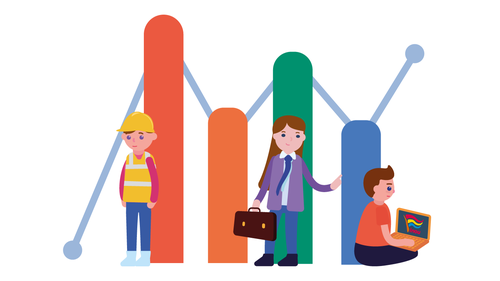On August 22nd, 2024 the Central Statistics Office (CSO) published the Labour Force Survey (LFS) for the second quarter of 2024, which covers the months April to June. In this quarter 131,200 people were unemployed, an increase of 9,000 people over the year. The unemployment rate in Q2 2024 was 4.6%, an increase of 0.2 percentage point (ppt) over the year. The unemployment rate for women was 4.5%, 0.3 ppt higher than the same quarter in 2023. The unemployment rate for men was 4.6%, the same as Quarter 2, 2023. Women accounted for 46.8% of the unemployed in Q2 2024, 1.5 percentage points higher than in Quarter 2 2023.
The unemployment rate for young people aged 15-24 years was 12%, a decrease of 0.2 percentage points over the year. The unemployment rate for people aged 25-74 years olds was 3.5%, an increase of 0.3 percentage point. Young people accounted for 34% of the unemployed in the second quarter of 2024, two percentage points lower than a year ago.
The number of people deemed long-term unemployed decreased by 14% over the year to 26,900 people. The long-term unemployment rate fell by 0.2 percentage point to 0.9%, the first time this figure has gone under 1%. The CSO notes that, excluding people whose duration was not stated, “Over a fifth (21.3%) of unemployed persons were in long-term unemployment in Q2 2024 which is down from 27.6% a year earlier”. Women accounted for 38% of the long-term unemployed in Q2 2024, unchanged on the same quarter in 2023.
The Potential Additional Labour Force (PALF) captures people who may not fit into the official definition of unemployment, whereby people have to be actively seeking work for the previous four weeks and available to take up work in the coming two weeks of the survey. In Q2 2024, PALF stood at 122,700, an increase of 22.6% or 22,600 people on Q2 2023. The CSO noted that “Of those who stated that they wanted to work but were not seeking work or available for work in Q2 2024, 35.2% said this was due to education or training. This compares to 28.7% a year earlier and 23.7% in Q2 2022. Persons not seeking work due to own illness or disability accounted for 28.6% of the total in Q2 2024, down from 32.6% in Q2 2023 and down from 35.4% in Q2 2022.”
Over the year the number of people employed in Ireland increased by 2.7% to 2,754,200 people. Full-time employment increased by 3% to 2,182,500 people, accounting for 79% of those in employment. The employment rate was 74.4%, an increase of 0.2 percentage point over the year, and an historic high. Women accounted for 42% of people in full-time employment in Quarter 2 2024, 0.7 percentage point higher than Q2 in 2023.
Over the year part-time employment increased by 1% to 571,600: within this figure, part-time underemployment increased by 1.3% to 141,800 people. In Q2 2024 women accounted for 67% of people in part-time employment, and 61.5% of people who were underemployed. In Q2 2023 these figures were 70% and 64% respectively.
Over the year the Labour Force rose by 2.9% to 2,885,400 people. The labour force consists of people who are in employment plus people who are unemployed. Two factors influence changes in the Labour Force: the demographic effect (+59,000) and the participatory effect (+21,500).
The participation rate in Q2 2024 was 66%, up 0.3 percentage point on Q2 2023. The participation rate measures the share of the total population aged 15 years and over who are in the labour force. Over the year the participation rate increased for men from 70.6% to 70.9%, and for women from 61% to 61.4%, the highest this figure has ever been. The participation rate for people aged 15-24 years was 54.2%, a decrease of 0.1 percentage point over the year.
